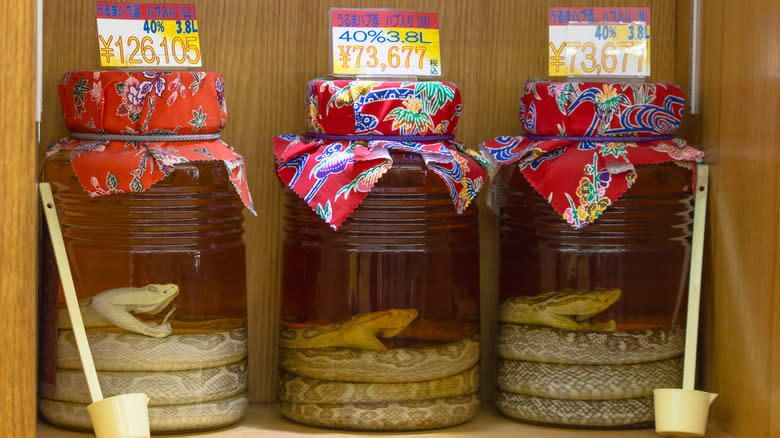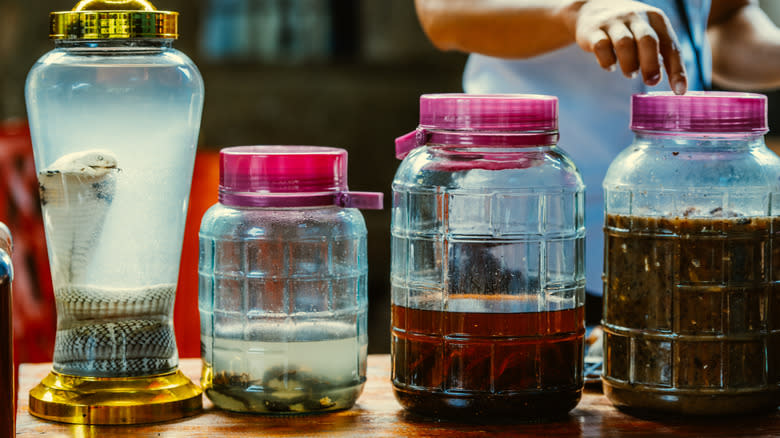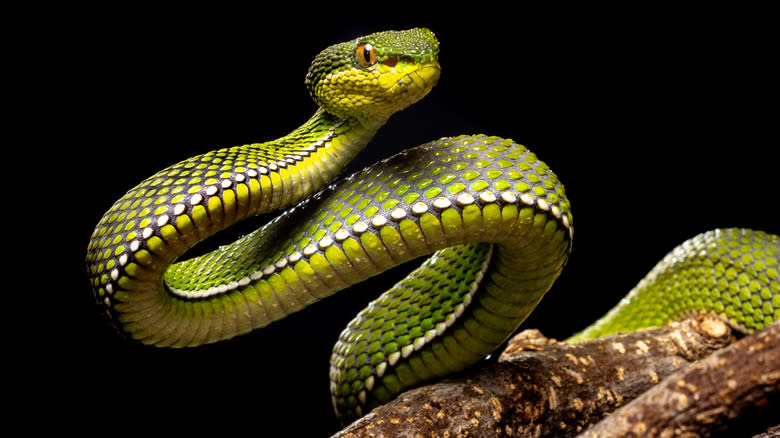Habushu Is The Japanese Snake Wine That's Surprisingly Pleasant To Drink

Snakes often evoke nervous reactions, whether you see them on a hike or a restaurant menu. Even within the culinary world, you'll see a whisky infused with the live reptiles in Thailand that's not for the faint of heart, and the once-popular snake soup in China is slowly dwindling due to the (debunked) fear that the animals transmitted Covid. And yet, not every delicacy involving snakes needs to prompt such a reaction.
If you've ever been to Japan, you may have seen Habushu, also called Okinawan Snake Wine or Habu Sake. This wine comes from the pit viper snake (aka the habu snake), which lives on the Ryukyu Islands in Japan. Consuming a beverage made from a venomous snake might sound terrifying at first, but you may be surprised to learn that its flavor typically won't hit you any harder than your favorite non-reptilian wine. This has to do with the other ingredients involved as well as the varying methods for making it. While it's possible to find this drink in Vietnam and Thailand, it originally came from Japan, so you may want to seek it out the next time you travel to the Land of the Rising Sun.
Read more: The 40 Absolute Best Cocktails That Feature Only 2 Ingredients
What Is Habushu And What Does It Taste Like?

While Habushu is often referred to as snake wine or sake, the name is actually a bit misleading. There are real snakes involved (and some may say they're the main attraction), and it makes sense that sake and Habushu get confused since they both come from fermented rice. But while sake is a brewed liquor, a different process is used to make the main boozy ingredient in Habushu: the unique awamori. This alcohol, which comes from Indica Thai rice that's been topped with black koji mold, is fermented and then distilled. While the Thai rice is used because it's more effective when paired with black koji mold, awamori itself is native to Okinawa in Japan, just like Habushu is.
A benefit of using awamori here is that it can be aged (often in clay pots), which ups the alcohol content and creates a smoother, deeper flavor. Yet, you'll still get a mild taste from Habushu, which is overall sweet with light herby, spicy notes. Because of the honey involved, it also has a nice tea-like aroma. But different bottles can offer varying flavors -- for example, one that still has the snake inside may have more kick, while one with more herbs will have a drier taste. Regardless, you'll generally see this drink with a pale yellow hue from the honey involved.
The Two Main Methods For Making Habushu

There are a couple different methods for making Habushu, and both are still used today. The most straightforward involves inserting a live pit viper snake into a large jug or jar with the awamori and other ingredients, where it then drowns. You'll typically see a combination of herbs, spices, and honey used, which is what gives the drink its pleasant flavor. Some recipes include as many as 13 different seasonings, such as fennel, hibiscus, and ginseng. But in case you're wondering, you won't suffer the wrath of the snake's venom when you drink Habushu; after it spends at least a month aging and soaking in all that alcohol, the venom's effects are nullified. Sometimes, the reptile is removed before the bottle of booze is sold, but it's often left in for the visual.
The other process for making Habushu involves rendering the snake unconscious before inserting it into the jar with the alcohol. In this case, brewers will use ice to do so — after which, they'll gut the reptile, sew it back up, and then place it in a container with ethanol for at least a month until it dies and purifies. Only then does the snake get transferred to a container with awamori, herbs, spices, and honey. The idea behind this method is that by gutting the reptile ahead of time, you remove all its parts that would cause an unpleasant smell.
Habushu Was Believed To Have Medicinal Properties

Habushu has a long history in Okinawa, going back as far as the 1300s, when it was a delicacy for the wealthy. Its value lied not only in its flavor but in people back then believing that it held medicinal properties as well -- an idea that may have been boosted by the drink's herbs and tea-like aroma and flavor. According to lore back in the day, Habushu was said to give strength, help with arthritis, remove poison from the body, and bolster libido. In some cases, it was even believed that drinking it could help protect you against evil spirits.
This boozy beverage was popularized amongst people of all classes in the 1900s, but it has since died out a bit. It's still sold in Japan as a novelty drink for tourists but, recently, it's had a bit of a resurgence in pop culture as well. Awich, a famous rapper from Okinawa, launched Habush in December 2022, her own line of Habushu. The bottles feature habu snake extract, awamori, and 13 different types of herbs, including fennel, clove, and Chinese pepper. Habush notes that it guts its snakes and removes their scent glands and intestines before using them to make booze, so this process is still alive and well in Japan today.
Read the original article on Tasting Table


